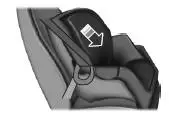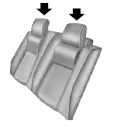Ford Mustang (2005-2014) Owners Manual: Installing child seats
Child Seats

Use a child safety seat (sometimes called an infant carrier, convertible seat, or toddler seat) for infants, toddlers or children weighing 40 pounds (18 kilograms) or less (generally age four or younger).
Using Lap and Shoulder Belts
WARNING: Airbags can kill or injure a child in a child seat.
Never place a rear-facing child seat in front of an active airbag.
If you must use a forward-facing child seat in the front seat, move the seat all the way back.
WARNING: Airbags can kill or injure a child in a child seat.
Children 12 and under should be properly restrained in the rear seat whenever possible.
WARNING: Depending on where you secure a child restraint, and depending on the child restraint design, you may block access to certain safety belt buckle assemblies or LATCH lower anchors, rendering those features potentially unusable. To avoid risk of injury, occupants should only use seating positions where they are able to be properly restrained.
When installing a child safety seat with combination lap and shoulder belts:
ŌĆó Use the correct safety belt buckle for that seating position.
ŌĆó Insert the belt tongue into the proper buckle until you hear a snap
and feel it latch. Make sure the tongue is securely fastened in the
buckle.
ŌĆó Keep the buckle release button pointing up and away from the safety
seat, with the tongue between the child seat and the release button,
to prevent accidental unbuckling.
ŌĆó Place the vehicle seat upon which the child seat will be installed in
the upright position.
ŌĆó Put the safety belt in the automatic locking mode. See Step 5.
This vehicle does not require the use of a locking clip.
Perform the following steps when installing the child seat with combination lap and shoulder belts: Note: Although the child seat illustrated is a forward-facing child seat, the steps are the same for installing a rear-facing child seat.

1. Position the child safety seat in a seat with a combination lap and shoulder belt.

2. Pull down on the shoulder belt and then grasp the shoulder belt and lap belt together.

3. While holding the shoulder and lap belt portions together, route the tongue through the child seat according to the child seat manufacturerŌĆÖs instructions. Be sure the belt webbing is not twisted.

4. Insert the belt tongue into the proper buckle (the buckle closest to the direction the tongue is coming from) for that seating position until you hear a snap and feel the latch engage. Make sure the tongue is latched securely by pulling on it.

5. To put the retractor in the automatic locking mode, grasp the shoulder portion of the belt and pull downward until all of the belt is pulled out.
Note: The automatic locking mode is available on the front passenger and rear seats. This vehicle does not require the use of a locking clip.
6. Allow the belt to retract to remove slack. The belt will click as it
retracts to indicate it is in the automatic locking mode.
7. Try to pull the belt out of the retractor to make sure the retractor is
in the automatic locking mode. You should not be able to pull more belt
out. If the retractor is not locked, unbuckle the belt and repeat Steps 5
and 6.

8. Remove remaining slack from the belt. Force the seat down with extra weight, for example, by pressing down or kneeling on the child restraint while pulling up on the shoulder belt in order to force slack from the belt.
This is necessary to remove the remaining slack that will exist once the extra weight of the child is added to the child restraint. It also helps to achieve the proper snugness of the child seat to your vehicle. Sometimes, a slight lean toward the buckle will provide extra help to remove remaining slack from the belt.
9. Attach the tether strap (if the child seat is equipped). See Using Tether Straps later in this chapter.

10. Before placing the child in the seat, forcibly move the seat forward and back to make sure the seat is securely held in place.
To check this, grab the seat at the belt path and attempt to move it side to side and forward and back. There should be no more than 1 inch (2.5 centimeters) of movement for proper installation.
Ford recommends checking with a NHTSA Certified Child Passenger Safety Technician to make certain the child restraint is properly installed.
In Canada, check with your local St. John Ambulance office for referral to a Child Passenger Safety Technician.
Using Lower Anchors and Tethers for CHildren (LATCH)
WARNING: Never attach two child safety seats to the same anchor. In a crash, one anchor may not be strong enough to hold two child safety seat attachments and may break, causing serious injury or death.
WARNING: Depending on where you secure a child restraint, and depending on the child restraint design, you may block access to certain safety belt buckle assemblies or LATCH lower anchors, rendering those features potentially unusable. To avoid risk of injury, occupants should only use seating positions where they are able to be properly restrained.
WARNING: The center of the rear seat is not designed as a seating position and is not equipped with safety belts. The LATCH anchors were not designed to be used with a child seat in the center position and there is no tether anchor available at the center. Attempted use of the center as a seating position will increase the risk of injury or death in the event of a crash.
The LATCH system is composed of three vehicle anchor points: two lower anchors located where seat back and seat cushion meet (called the seat bight) and one top tether anchor located behind that seating position.
LATCH compatible child safety seats have two rigid or webbing mounted attachments that connect to the two lower anchors at the LATCH equipped seating positions in your vehicle. This type of attachment method eliminates the need to use safety belts to attach the child seat, however the safety belt can still be used to attach the child seat.
For forward-facing child seats, the top tether strap must also be attached to the proper top tether anchor, if a top tether strap has been provided with your child seat.

Your vehicle has LATCH lower anchors for child seat installation at the seating positions marked with the child seat symbol.

The LATCH anchors are located at the rear section of the rear seat between the cushion and seat back below the symbols as shown.
Follow the child seat manufacturerŌĆÖs instructions to properly install a child seat with LATCH attachments.
Follow the instructions on attaching child safety seats with tether straps.
See Using Tether Straps later in this chapter.
Attach LATCH lower attachments of the child seat only to the anchors shown.
Combining Safety Belt and LATCH Lower Anchors for Attaching Child Safety Seats
When used in combination, either the safety belt or the LATCH lower anchors may be attached first, provided a proper installation is achieved.
Attach the tether strap afterward, if included with the child seat.
Using Tether Straps
 Many forward-facing child safety
seats include a tether strap
which extends from the back of the child safety seat and hooks
to an anchoring point called the top tether anchor. Tether
straps are available as an accessory for many older safety seats.
Many forward-facing child safety
seats include a tether strap
which extends from the back of the child safety seat and hooks
to an anchoring point called the top tether anchor. Tether
straps are available as an accessory for many older safety seats.
Contact the manufacturer of your child seat for information about ordering a tether strap, or to obtain a longer tether strap if the tether strap on your safety seat does not reach the appropriate top tether anchor in your vehicle.
Once the child safety seat has been installed using either the safety belt, the lower anchors of the LATCH system, or both, you can attach the top tether strap.

The tether strap anchors in your vehicle are in the following positions (shown from top view):
Perform the following steps to attach a child safety seat to the tether anchor:
For coupe:
1. Route the tether strap over the top of the head restraint.

2. Locate the correct anchor for the
selected seating position.
3. Open the tether anchor cover.

4. Clip the tether strap to the anchor as shown.
If the tether strap is clipped incorrectly, the child safety seat may not be retained properly in the event of a crash.
5. Tighten the child safety seat tether strap according to the manufacturerŌĆÖs instructions.
If the safety seat is not anchored properly, the risk of a child being injured in a collision greatly increases.
For convertible:
1. Route the child safety seat tether strap over the top of the head restraint.

The tether anchors are located rearward of the seat back in the convertible top sling.
Note: For easier access, attach the tether with the convertible top up.

Note: The attachments for the convertible boot located on the back of the head restraints are not tether anchors.

2. Access tether anchors located behind the seat back under the vinyl tag marked with the child tether anchor symbol.

3. Clip the tether strap to the anchor as shown.
If the tether strap is clipped incorrectly, the child safety seat may not be retained properly in the event of a crash.
4. Tighten the child safety seat tether strap according to the manufacturerŌĆÖs instructions.
If the safety seat is not anchored properly, the risk of a child being injured in a collision greatly increases.
If your child restraint system is equipped with a tether strap, and the child restraint manufacturer recommends its use, Ford also recommends its use
 Booster seats
Booster seats
WARNING: Never place, or allow a child to place, the shoulder
belt under a childŌĆÖs arm or behind the back because it reduces
the protection for the upper part of the body and may increase the risk
o ...
 Safety Belts
Safety Belts
PRINCIPLES OF OPERATION
WARNING: Always drive and ride with your seat back upright
and the lap belt snug and low across the hips
WARNING: To reduce the risk of injury, make sure children sit
where the ...
Other materials:
Final assembly
23. Install the differential assembly in the differential housing. For
additional information, refer to
Differential Case in this section.
24. CAUTION: Align the index marks.
CAUTION: Install the driveshaft with new bolts. If new bolts are not available,
a ...
Chuckle
Chuckle that occurs on the coast driving phase is usually caused by excessive
clearance between the
differential gear hub and the differential case bore.
Damage to a gear tooth on the coast side can cause a noise identical to a
chuckle. A very small tooth
n ...
Catalyst Monitor Sensor
Special Tool(s)
Socket, Exhaust Gas Oxygen
Sensor
303-476 (T94P-9472-A)
Material
Item
Specification
Penetrating and Lock Lubricant
or equivalent
E8AZ-19A501-
B
Removal and Installation
1. Disconnect the battery ground ...
